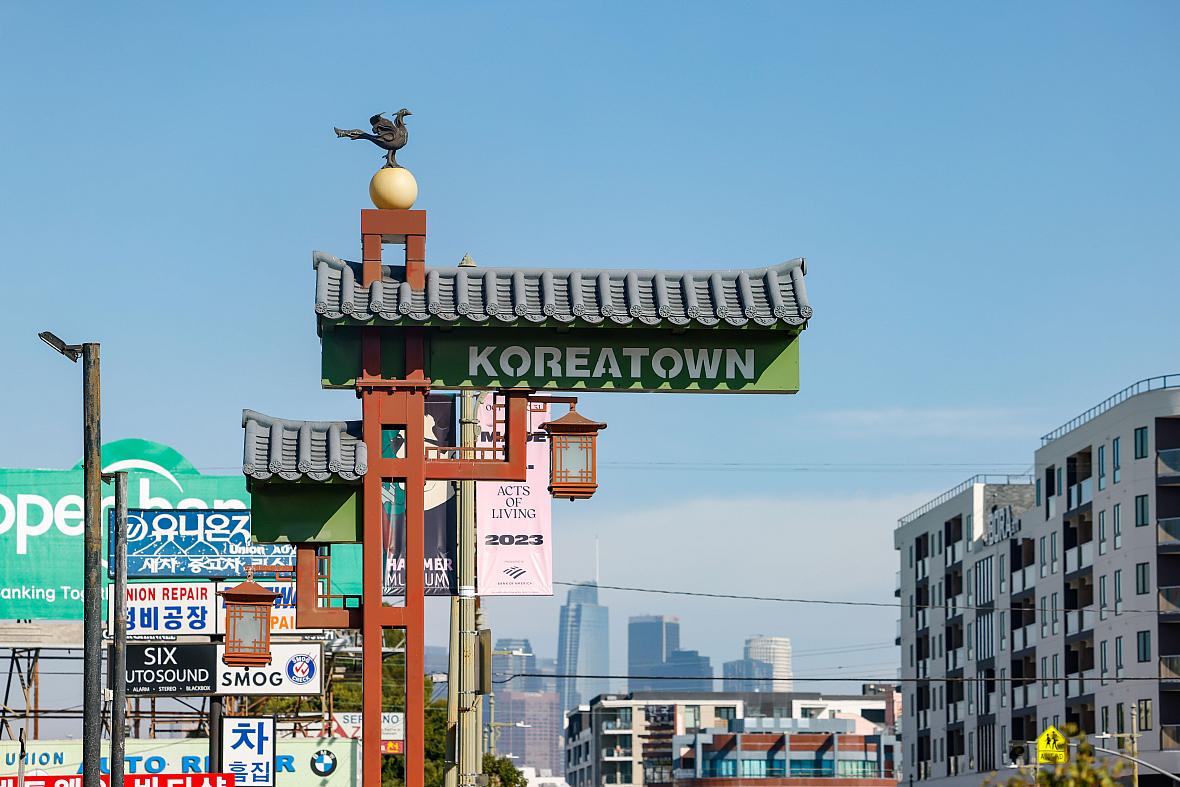LA Koreatown Seniors Wait Over a Decade to Move Into Subsidized Housing
The story was co-published with Korea Daily as part of the 2024 Ethnic Media Collaborative, Healing California.

Koreatown in Los Angeles, a densely populated neighborhood in Los Angeles. There are 110,047 people living in the 2.9 square miles east and west of Hoover Street/Western Avenue and north and south of Pico Boulevard/Beverly Boulevard that mark the borders of Koreatown.
Jason Armond / Los Angeles Times via Getty Images
In the Country Club neighborhood southwest of Koreatown, an 85-year-old resident S, who asked to remain anonymous, can be seen rummaging through neighborhood trash bins with a shopping cart. She searches for aluminum cans and plastic bottles. “Collecting cans and plastic bottles is just a hobby,” she said, quickly adding, “This way, I earn about $200 a month, which helps cover my living expenses.”
S collects collects cans and bottles because she can’t afford rent on her own. She receives approximately $1,000 a month in Supplemental Security Income (SSI), out of which she pays $700 to rent a single room in someone’s house. “In this neighborhood, you have to pay this much to get even one room,” she said. She has been on the waiting list for subsidized senior apartments for over a decade. "If you go into a senior apartment, you only have to pay $250 to $300. I’ve been waiting for 13 years. Now I just gave up,” she said.
Low-income residents and seniors like S are struggling with unaffordable rents in LA's Koreatown, where the city's largest concentration of Koreans and Korean Americans reside. Dreaming of moving into a government-subsidized low-income and senior apartment, many residents are frustrated by the thousands on waiting lists that stretch into decades.
A quick glance at the Los Angeles County Development Authority website revealed that many of the waiting lists are currently closed. An analysis of the City of Los Angeles Housing Department (LAHD) website’s affordable senior housing listings show that as of July 1, 2024, not a single one is accepting new tenants.
According to the housing department statistics, there are 124 low-income and senior apartments in the zip codes that include Koreatown (90004, 90005, 90006, 90010, 90019, 90020, 90057), totaling 6,602 units. Of these, 74 buildings and 3,229 units are closed to new applications, with the remainder of the apartments only accepting waitlists for unforeseeable vacancies.
Overcrowding and Dearth of Public Housing
The 2020 Census data indicates that Koreatown is the most densely populated neighborhood in Los Angeles. There are 110,047 people living in the 2.9 square miles of east and west of Hoover Street/Western Avenue and north and south of Pico Boulevard/Beverly Boulevard.
Koreatown is the only neighborhood in the city that comes close to 40,000 people per square mile. Koreatown’s population density is more than double that of Downtown LA, Central City/Boyle Heights, and Mid-Wilshire.
Amid the high concentration of residents, there is a severe shortage of low-income and senior apartments in Koreatown. The government-assisted public housing for these residents has been slow to be built, exacerbating the economic hardship of low-income and senior residents.
For example, the nonprofit Korean Resource Center (KRC) has been operating two senior apartments, totaling 67 units, in Koreatown with federal funding since 2016. “We currently have about 3,000 people waiting to move into our apartments,” said the manager of the senior apartments, “and we are not accepting new applications because there are just so many people waiting already.”
According to KRC, Koreatown’s rents for a studio start at $1,200, a one-bedroom at $1,600, and a two-bedroom at $2,000. New apartments cost even more.
The 2020 Census indicated that Koreatown’s median household income is $46,000, less than $4,000 per month.“Residents should ideally spend 30% of their income on rent, but many in Koreatown spend over 50%, making life extremely tight,” said Jacqueline Jung from KRC.
The nonprofit Koreatown Youth and Community Center (KYCC) operates 10 low-income and senior apartments in Koreatown, totaling 348 units. “All of our units are occupied,” KYCC said. “We have a long waiting list. Even qualified new applicants have to wait about 10 years to get in.”
The boom in new development has led to the loss of even rent-stabilized apartments, which are legally guaranteed to be affordable, further reducing the number of low-income housing options. Low-income people and seniors are disproportionately affected.
A representative of the LA Tenants Union (LATU) Koreatown branch added, “LA city officials and private developers are demolishing old apartments in Koreatown to build new ones. Every week, landlords attempt to evict tenants from an average of 12 apartments in Koreatown, threatening tenant safety and housing stability.”
“People in their 40s, 50s, and older who have lost their jobs since the pandemic can’t afford rent and can’t find a place to stay right away,” said Jeff Lee, executive director of the Korean American Federation of Los Angeles (KAFLA). “Seniors, whose Supplemental Security Income (SSI) pays for boarding or a room for a month, often have only $100 to $200 left over to pay for food and rely on food banks,” Lee said.
Older adults who are struggling to pay rent are forced to cut back on health care, food, and other basic necessities. Unaffordable rent burdens negatively affect overall health, with increased risk of depression and anxiety and a host of physical conditions, according to a Justice in Aging policy brief.
A Daily Struggle
On June 26, a 50-year-old woman named Jung came to the Korean Resource Center (KRC) for counseling on applying for a low-income apartment. “My husband is the only one who earns money. We pay $1,600 a month for rent for a one-bed apartment, and that makes it just too difficult to live.” Her husband earns an income of less than $2,000 per month. “Rent is our biggest problem,” she added.
“About 10 low-income and senior residents come to us for counseling every day, but in the end, they just have to wait because there is no supply at all,” said Jacklyn Jung of the KRC.
Ktown Action's President, Dae-jung Yoon, said a total of 222 new apartments were approved by the LA city government in the Wilshire neighborhood in the center of Koreatown from 2017 to 2023. While a total of 14,000 new units were created, only 2,260 units were reserved for the low-income and seniors — just 16% of the total number of units.
Steve Kang, Director of External Affairs at KYCC, said, “With so many new buildings, the cost of living in Koreatown has gone up. Even when private developers build new apartments, they only set aside about 10 percent of the units for low-income and senior residents,” adding, “The government should be building dedicated apartments that are 100 percent for low-income and senior housing.”
Jacqueline Jung from KRC urged residents in search of affordable housing to stay informed and proactive.“Regularly seeking information from nonprofits can significantly aid in securing affordable housing,” she said.
No Place to Go Even if You Qualify for Section 8 Vouchers
In October 2022, the city of Los Angeles reopened the waiting list for Section 8 vouchers, which subsidizes rent for low-income residents, after a five-year hiatus. More than 100,000 people signed up in a single day. According to Korean-American organizations, including the KAFLA, about 1,500 Korean Americans applied at the time.
Two years later, it’s still tough to find any of them in low-income apartments. Even if they are on the waiting list, the wait time to move in is nearly 10 years because there is simply not enough supply, according to officials.
One of the biggest challenges for low-income residents of Koreatown is the rapidly rising cost of rent. However, if you win a Section 8 voucher, you only pay about 30% of your income for rent, and the government pays the rest. This is why Section 8 vouchers are often referred to as the “lottery.” However, there are very few apartments available to those who win a Section 8 voucher. Most are frustrated by the thousands on the waiting list.
“Winning a Section 8 voucher is extremely difficult, and even if you win, finding an apartment is another hurdle,” said Jeff Lee, from KAFLA. “Of the 450 Koreans we helped apply two years ago, there are about 50 who were placed on the waiting list and we helped them through the process,” said Lee, “but none of them have been contacted to submit documents to move into an apartment.”
In an email to Section 8 recipients, the housing department informs the applicants that “the waiting period to move into an apartment can be as long as 10 years.”
Preserving Low-Income Apartments is Critical
Nonprofits emphasized that local governments, such as the City of Los Angeles, should retain rent-controlled apartments as much as possible to reduce the burden on low-income tenants.
“The city should protect existing tenants instead of approving new developments that would tear down older rent-controlled apartments,” said the LA Tenants Union.

There should also be rewards for private apartment landlords to take Section 8 recipients as tenants. 65-year-old Koreatown resident Byungyeon Lee, who has lived in a privately owned apartment with Section 8 subsidies for 15 years, said, “There are no apartments for Section 8 winners right now. It should be institutionalized so that landlords don’t lose rental revenue by letting in government-subsidized tenants.”
A 75-year-old resident surnamed Choi won Section 8 five years ago and moved from her old apartment to a new one in Koreatown in early June. Choi pays $250 a month in rent. “My friends are jealous that I won the lottery,” Choi says, adding, “If you want rent assistance, you have to keep knocking on the doors of nonprofits like the KRC. You have to seek out information on your own and be proactive to have a chance.”
This project is supported by the USC Annenberg Center for Health Journalism, and is part of “Healing California,” a yearlong reporting Ethnic Media Collaborative venture with print, online and broadcast outlets across California.
